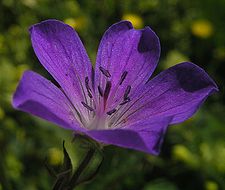- Mesangiospermae
-
?Mesangiospermas
Geranium (Geraniaceae) Clasificación científica Reino: Plantae Clados superiores: Archaeplastida
Viridiplantae
Streptophyta
Streptophytina
Embryophyta
Tracheophyta
Euphyllophyta
Lignophyta
SpermatophytaDivisión: Angiospermae Clados y órdenes[2] - Mesangiospermae M.J. Donoghue, J.A. Doyle & P.D. Cantino.[1]
- Chloranthaceae
- Ceratophyllaceae
- Magnoliidae
- Monocotyledoneae
- Eudicotyledoneae
En Nomenclatura filogenética, las mesangiospermas (Mesangiospermae) son un grupo extremadamente amplio y diverso de angiospermas, con un gran variabilidad en el hábito, morfología, química, distribución geográfica y otros atributos. La sistemática clásica, basada únicamente en información morfológica, no fue capaz de reconocer este grupo. De hecho, la circunscripción de las mesangiospermas como un clado está basada en una fuerte evidencia a partir de los datos de análisis moleculares.[3] [4] [5] [6] El clado está compuesto por las clorantáceas, las ceratofiláceas y la totalidad de los clados de magnólidas, monocotiledóneas y eudicotiledóneas Este clado ha recibido otros nombres informalmente en diversas publicaciones, tales como "núcleo de las angiospermas" y "euangiospemas". Mesangiospermae es una traducción del primero de tales nombres, ya que el prefijo “mes-” significa “medio” o “central".[7]
Referencias
- ↑ MesangiospermaeM.J. Donoghue, J.A. Doyle & P.D. Cantino. En: P.D. Cantino, J.A. Doyle, S.W. Graham, W. S. Judd, R.G. Olmstead, D. E. Soltis, P.S. Soltis & M.J. Donoghue. 2007. Towards a phylogenetic nomenclature of Tracheophyta. Taxon 56 (3) 822–846
- ↑ The Angiosperm Phylogeny Group III ("APG III", en orden alfabético: Brigitta Bremer, Kåre Bremer, Mark W. Chase, Michael F. Fay, James L. Reveal, Douglas E. Soltis, Pamela S. Soltis y Peter F. Stevens, además colaboraron Arne A. Anderberg, Michael J. Moore, Richard G. Olmstead, Paula J. Rudall, Kenneth J. Sytsma, David C. Tank, Kenneth Wurdack, Jenny Q.-Y. Xiang y Sue Zmarzty) (2009). «An update of the Angiosperm Phylogeny Group classification for the orders and families of flowering plants: APG III.» (pdf). Botanical Journal of the Linnean Society (161): pp. 105-121. http://www3.interscience.wiley.com/journal/122630309/abstract.
- ↑ Hoot, S. B., S. Magallón, and P. R. Crane. 1999. Phylogeny of basal eudicots based on three molecular data sets: atpB, rbcL, and 18S nuclear ribosomal DNA sequences. Annals of the Missouri Botanical Garden 86: 1-32
- ↑ Savolainen, V., M. W. Chase, C. M. Morton, D. E. Soltis, C. Bayer, M. F. Fay, A. De Bruijn, S. Sullivan, and Y.-L. Qiu. 2000a. Phylogenetics of flowering plants based upon a combined analysis of plastid atpB and rbcL gene sequences. Systematic Biology 49: 306-362
- ↑ Soltis, D. E., P. S. Soltis, M. W. Chase, M. E. Mort, D. C. Albach, M. Zanis, V. Savolainen, W. J. Hahn, S. B. Hoot, M. F. Fay, M. Axtell, S. M. Swensen, L. M. Prince, W. J. Kress, K. C. Nixon, and J. S. Farris. 2000. Angiosperm phylogeny inferred from 18S rDNA, rbcL, and atpB sequences. Botanical Journal of the Linnean Society 133: 381-461.
- ↑ Douglas E. Soltis, Stephen A. Smith, Nico Cellinese, Kenneth J. Wurdack, David C. Tank, Samuel F. Brockington, Nancy F. Refulio-Rodriguez, Jay B. Walker, Michael J. Moore, Barbara S. Carlsward, Charles D. Bell, Maribeth Latvis, Sunny Crawley, Chelsea Black, Diaga Diouf, Zhenxiang Xi, Catherine A. Rushworth, Matthew A. Gitzendanner, Kenneth J. Sytsma, Yin-Long Qiu, Khidir W. Hilu, Charles C. Davis, Michael J. Sanderson, Reed S. Beaman, Richard G. Olmstead, Walter S. Judd, Michael J. Donoghue, and Pamela S. Soltis Angiosperm phylogeny: 17 genes, 640 taxa Am. J. Bot. April 2011 98:704-730
- ↑ P.D. Cantino, J.A. Doyle, S.W. Graham, W. S. Judd, R.G. Olmstead, D. E. Soltis, P.S. Soltis & M.J. Donoghue. 2007. Towards a phylogenetic nomenclature of Tracheophyta. Taxon 56 (3) 822–846
Wikimedia foundation. 2010.

